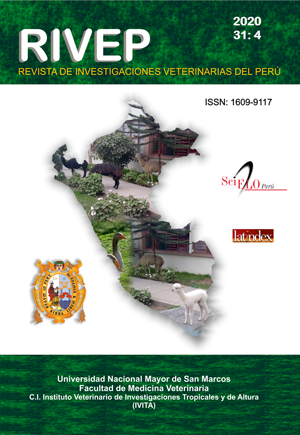Chemical characteristics of the silage of rachis of banana (Musa paradisiaca) and baby banana (Musa acuminata AA) treated with whey and urea
DOI:
https://doi.org/10.15381/rivep.v31i4.19035Keywords:
animal feed, chemical components, solid fermented, banana residues, plantain residuesAbstract
The chemical characteristics of a silage of banana (Musa paradisiaca) and baby banana (Musa acuminata AA) rachis treated with whey and urea were evaluated. In total, 24 microsilos of 1 kg capacity were prepared and the pH, dry matter (DM), crude protein (CP), crude fiber (CF), ashes, ether extract (EE), nitrogen-free extracts (NFE) and gross energy (GE) were determined at 0, 1, 4, 8, 15 and 30 days of conservation (four microsilos for each day). The silage material presented an adequate pH and produced significant increases in the content of DM, CP, ash, EE, NFE and GE and a reduction in the content of CF, with respect to the rachis in its natural state. There was an absence of Escherichia coli, Clostridium spp and Salmonella spp. Mild and strong acid odor, light and dark brown color and solid and semi-solid consistency were evident. The use of drying material, molasses, urea and whey allowed to improve the nutritional composition of plantain and banana rachis, generating a feed of appreciated nutritional quality for use as animal feed.
Downloads
Downloads
Published
Issue
Section
License
Copyright (c) 2020 Willan Caicedo, Derwin Viáfara, Manuel Pérez, Felipe Norberto Alves Ferreira, Gabriel Rubio, Reinaldo Yanza, María Caicedo, Luis Caicedo, Segundo Valle, Walter Motta Ferreira

This work is licensed under a Creative Commons Attribution-NonCommercial-ShareAlike 4.0 International License.
AUTHORS RETAIN THEIR RIGHTS:
a. Authors retain their trade mark rights and patent, and also on any process or procedure described in the article.
b. Authors retain their right to share, copy, distribute, perform and publicly communicate their article (eg, to place their article in an institutional repository or publish it in a book), with an acknowledgment of its initial publication in the Revista de Investigaciones Veterinarias del Perú (RIVEP).
c. Authors retain theirs right to make a subsequent publication of their work, to use the article or any part thereof (eg a compilation of his papers, lecture notes, thesis, or a book), always indicating the source of publication (the originator of the work, journal, volume, number and date).



